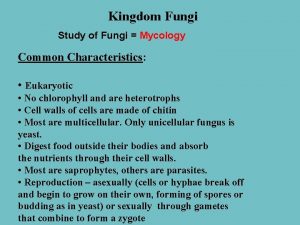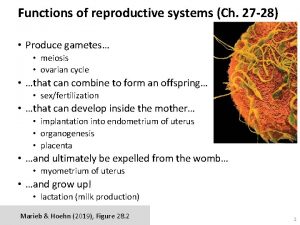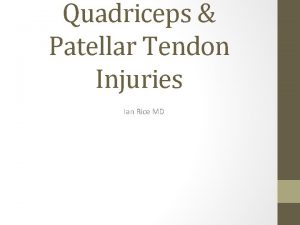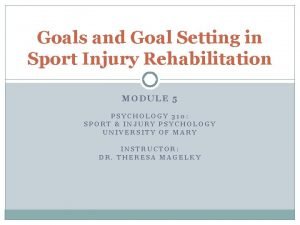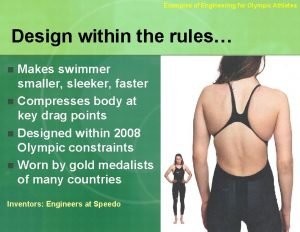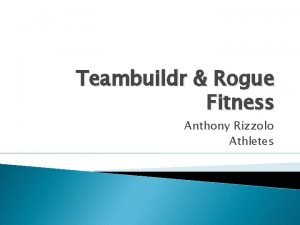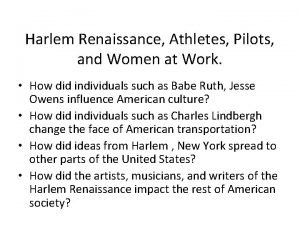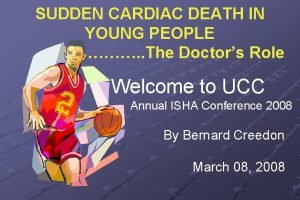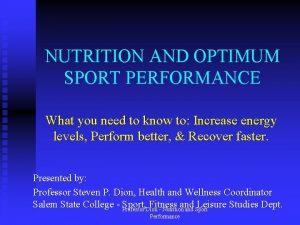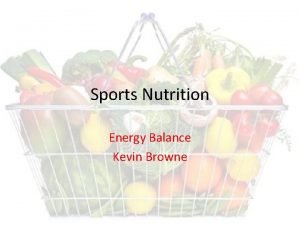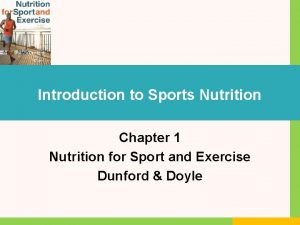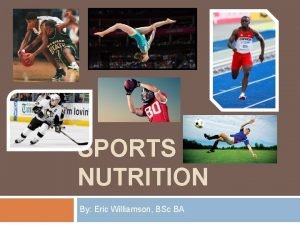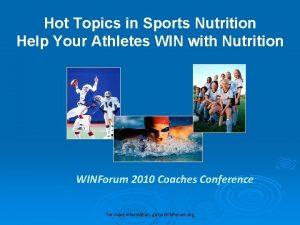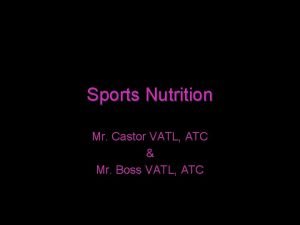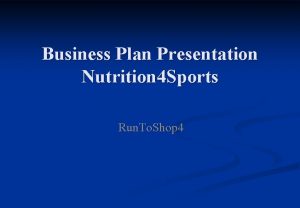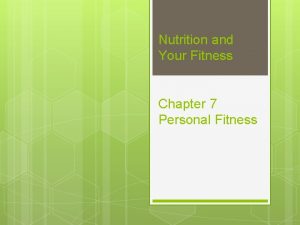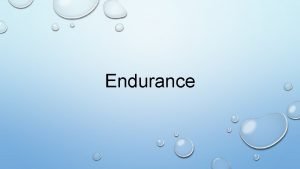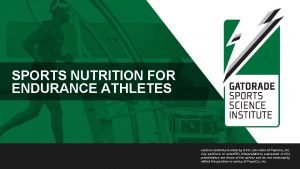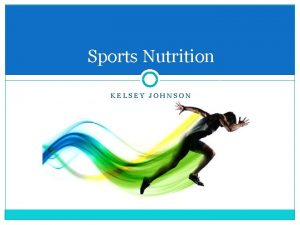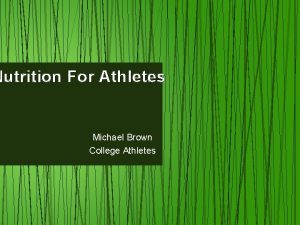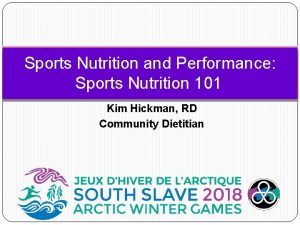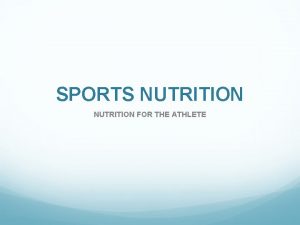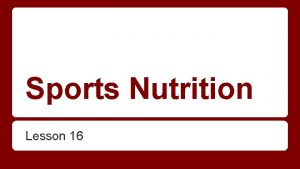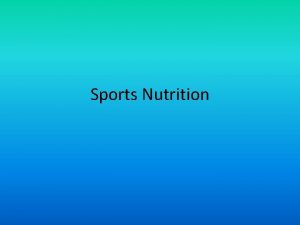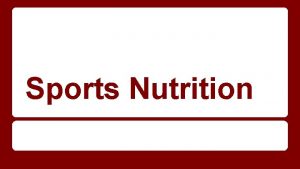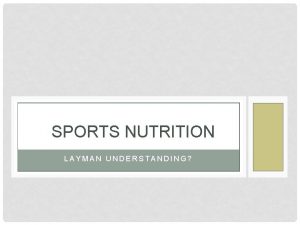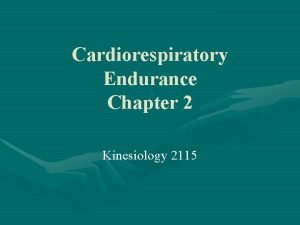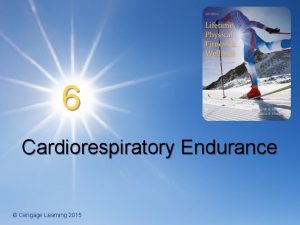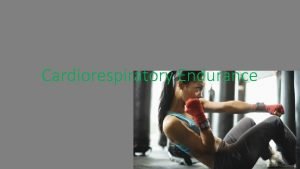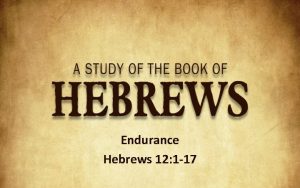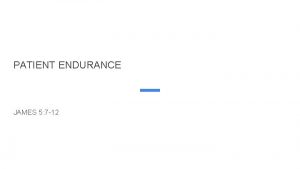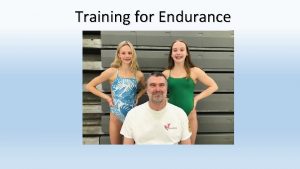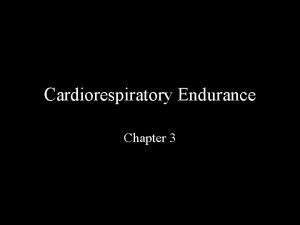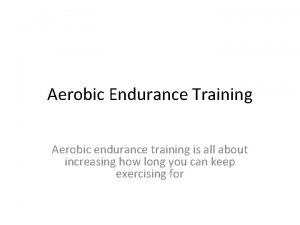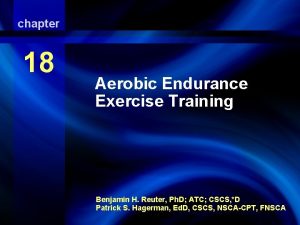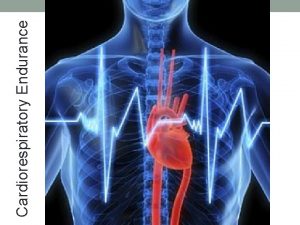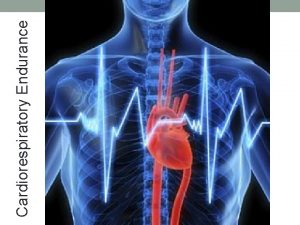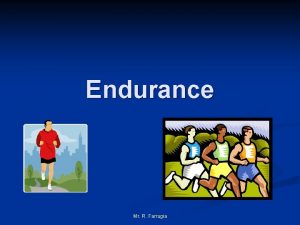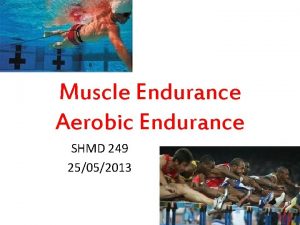Sports Nutrition for Young Endurance Athletes Kelsey Smith































- Slides: 31

Sports Nutrition for Young Endurance Athletes Kelsey Smith, MS, RDN, LD

Why sports nutrition? ● You need to EAT to COMPETE. Food is FUEL. ● What it boils down to is nutritious food in the right portion at the right time ● If you do not eat well, you risk poor performance, nutrient deficiencies, poor growth, and decreased immunity.

Carbohydrates ● Function: your body’s preferred energy source ● Breaks down to glucose (sugar) to be used immediately or stored as glycogen ● 45 -65% of diet should come from carbs ● Examples: bread, pasta, cereal, potatoes, and beans, fruit, milk ● I’m a runner… I should be carb loading, right? ? ○ Children are more limited than adults in how much carbohydrate their muscles can store (and girls are even more limited than guys) ○ A 5 k is a relatively short race & unlikely to deplete glycogen stores ○ A better strategy is eating carbs at regular intervals throughout and before/after training sessions

Protein ● Function: ○ Helps your body repair damaged cells and make new ones ○ Aids in immunity and bone formation ● 12 -15% of total calories should come from protein ○ Goal= 0. 6 g/lb or 1. 5 g/kg per day ○ For a 120 lb female, this would be ~72 g/day ● Can only utilize about 20 -30 g of protein as amino acid at 1 time ○ Protein intake >30 g at 1 time will provide calorie, but not AA ○ For example: 3 oz of chicken breast has 25 g/protein ○ Most people eat very little at breakfast, some at lunch, a lot at dinnerconsistent intake throughout the day and after hard training is much better ● Examples: steak, chicken, eggs, cheese, milk, beans, legumes, nuts, soy

Fats ● Function: ○ Huge energy source! ○ Helps you digest fat soluble vitamins like A, D, E, & K ● 25 -35% of daily calories from fat ○ Most of these should come from MUFA or PUFA (plant sources): canola oil, peanut butter, avocado, salmon, walnuts, etc ○ Less than 10% should come from saturated fat (animal sources): full fat dairy, butter, high fat beef ○ Less than 1% from trans fats (packages products like baked goods) ● Eating fat does not make you fat!!

Fruits and Vegetables Rich in vitamin/mineral, phytochemicals, and fiber to improve immune function

Easy Training Day Easy training days are generally described as lower intensity training that lasts for less than 60 minutes. This plate is best used… ● in the off-season ● during a period of light training ● if an athlete is trying to lose weight during the off-season

Moderate Training Day Moderate training days are generally described as… ● higher intensity training that lasts for < 60 minutes ● lower intensity activity that lasts < 90 minutes ● two training sessions in one day with both training sessions being of easy to moderate intensity and lasting less than 1 hour

Hard Training Days Hard training days are generally described as. . . ● higher intensity training that lasts > 60 minutes ● lower intensity activity that lasts a > 90 minutes ● two training sessions in one day with at least one of the sessions being high intensity

Nutrition Before Exercise ● GOAL= top off your energy store ● AM exercise: EAT BREAKFAST ● PM exercise: EAT LUNCH 1 hour= 1 food item Crackers, yogurt, applesauce or liquids like sports drink 2 hours= 2 food items Peanut butter sandwich with fruit 3 hours= 3 food items Pasta with chicken and yogurt 4 hours= 4 food items Full meal: carb, protein, fruit/vegetable and yogurt

Nutrition During Exercise ● GOAL= stay hydrated and replenish blood glucose ● Dehydration cause fatigue and impair performance ● What to Eat/Drink: ○ Water is good at any time! Particularly for light exercise that lasts less than 1 hr ○ Use sports drinks for vigorous activity last over 1 hr: provides you with fluid, carbs, and electrolytes

Nutrition After Exercise ● GOALS= ○ restore fluid and electrolytes lost in sweat ○ replace glycogen stores (carbohydrate in your muscle) ○ provide protein to aid in repair of damaged muscles ● It is best to begin your nutrition recovery 15 -30 min after exercise ● What to Eat= fluids, carbs, and a small/moderate amount of protein (especially following a hard workout) ● Carbs restore depleted glycogen, but also stimulates insulin secretion ○ In fact, failure to consume enough carbs after intense exercise results in higher levels of muscle breakdown ● Aim for ~20 g protein + carbs for long runs or hard workout/race days

Snack ideas: within 1 hour after exercise ● ● ● ● Low-fat chocolate milk + banana or applesauce 4 -8 Graham cracker +2 tbsp peanut butter 6 oz Greek yogurt + ¾ cup berries ¼ cup hummus or edamame and whole wheat pita or pretzels Low-fat cheese on whole grain crackers and apple slices 1 -2 oz of beef/turkey jerky and 4 whole wheat crackers Sports drink and a granola bar (at least 10 g protein) ½ cup trail mix (mixed nuts, dried fruit and a few chocolate pieces)

Hydration ● Dehydration is the #1 cause of decreased performance in athletes ○ Even being dehydrated by 2% can cause decline in performance ○ Up to 75% of athletes aged 8 -18 come to practice dehydrated ● Sweat= your body’s AC unit (it allows your body to release the build up of heat) ● When you sweat, you lose fluids, sodium, potassium, and chloride ● Loss in blood volume=less blood and oxygen are going to your muscles; less waste is being carried away ● Also causes elevation in temperature and heart rate (REP increases) ● Throughout the day: Look at color of urine (correlates with your hydration 2 hours ago) → Aim for very pale yellow like fresh lemonade

Fluid Timing 2 -3 hours before activity 16 -20 oz mostly water 1 hour before activity Sip a sports drink (about 1 oz every 5 minutes) Every 15 -20 minutes during activity 4 -8 oz water or sports drink ● Sports drink during exercise lasting 1 hour or longer OR in very hot/humid conditions OR very strenuous OR multiple sessions per day ● Sports drinks have electrolytes and often have a mix of sugars to diversify pathways After activity 16 oz for each lb lost during activity

Iron ● Functions= ○ Helps your body make hemoglobin and myoglobin, which carry oxygen throughout your body ○ Part of numerous oxidative enzymes (essential for aerobic metabolism) ● Low iron intake + iron losses= poor oxygen-carry capacity ○ THIS IS PROBLEM FOR ENDURANCE ATHLETES ● Heme Iron= Increased bioavailability ○ Red meat, dark meat poultry, egg, fish/shellfish ● Non-Heme Iron= Decreased bioavailability ○ Lentils and other legumes, dark leafy vegetables, dried fruits like raisins, iron fortified grains

Nutrients Impacting Iron Absorption ● Vitamin C= enhances the absorption ○ Oranges and other citrus, peppers, strawberries, broccoli, tomatoes ● Calcium= (and other divalent minerals like Mg and Zn) inhibits absorption ○ Dairy products, soy ● Caffeine= inhibits iron absorption ○ Coffee, tea, chocolate ● Phytates= inhibits iron absorption ○ Whole grains, beans, seeds, bran cereals ● Oxalic Acid= inhibits iron absorption ○ green vegetables like bok choy, broccoli, kale ○ blanching them in hot water for a few seconds will help leach the oxalic acid but keep the minerals intact

Symptoms of Iron Deficiency ● Fatigue ● Decreased cognitive function ● Shortness of breath ● Cold hands and feet (poor temperature regulation) ● Cravings for ice, dirt or clay ● Brittle or spoon shaped nails or hair loss ● Sores at the corner of your mouth

Iron Deficiency vs Iron Deficiency Anemia ● Iron Deficiency Anemia: low Hgb/Hct, low MCV, low ferritin ● Iron Deficiency without Anemia: normal Hgb/Hct, low ferritin and/or transferrin ● 2014 study on iron deficiency in high school female athletes aged 15 -17 ○ 52% had iron deficiency ○ 9% had iron deficiency anemia ○ *iron deficiency was still found in those with higher intakes of iron and less menstrual bleeding ● Lab values to request for blood test: Hgb, Ht, Ferritin, MCV, MCH, Transferrin (possibly more)

If iron is so great, shouldn’t we all take it? NO. ● ● Iron overload disease is potentially fatal. There is NO benefit unless deficiency is demonstrated. If you suspect deficiency, get the lab testing to confirm. Until then, focus on iron rich foods.

Calcium ● ● Function= Bone health, muscle contraction, & blood clotting The body will always keep the blood levels steady If dietary intake is insufficient, then calcium will be taken from the bones Calcium intake: 1300 mg/day (matches the highest of any point in life)= peak bone accumulation ● Good sources: Yogurt, cheese, milk, soy milk, tofu, fortified orange juice, kale, bok choy, broccoli ○ Note: oxalic acid in green vegetable inhibits calcium absorption, but blanching them in hot water for a few seconds will help leach the oxalic acid but keep the calcium intact ● 60% of cases of adult osteoporosis are related to low bone content developed during teen years

Vitamin D ● Function= Helps bone health by aiding calcium absorption in the gut, helps the functioning of the immune system, has a role in reducing inflammation ● We get vitamin D from… ○ SUN EXPOSURE ○ Tuna, mackerel, salmon, cod liver oil, fortified milk, fortified orange juice, yogurt, ready-to-eat cereal, egg ● Very few people show signs of deficiency, but some of the more common symptoms are fatigue, muscle weakness, hair loss, frequent infection, & more ● It is unlikely for XC/track runners, but risk increases with inadequate intake and darker skin tones

Example: 16 yo F, 5’ 3”, 115 lb= 2400 kcal/day 7: 00 am 1 cup 2% Greek yogurt, ½ cup fresh berries, drizzle of honey, ½ English muffin with jam 10: 00 am 1 cup raw carrots with yogurt based ranch 12: 00 pm Sandwich (2 oz deli turkey + 2 slices of whole grain bread + ½ cup spinach + tomato slices) with 1 cup bell peppers with ¼ cup hummus 2: 30 pm ½ cup grapes, 4 graham crackers + 20 oz of water 4: 00 pm 16 oz of sports drink plus additional water (hard workout or hot) 5: 30 pm 8 oz chocolate milk, 1 banana 7: 30 pm 3 oz lemon pepper chicken, 1 cup wild rice, 1 cup roasted green beans 9: 30 pm 1 cup 1% milk, 1 cup cereal (Cheerios, Total, Kashi)

Example: 17 yo M, 5’ 11”, 155 lb= 3200 kcal/day 7: 00 am 2 scrambled eggs with ½ cup spinach and mushroom, 1 cup oatmeal with ¼ cup raisins and brown sugar 10: 00 am 1 cup raw carrots and yogurt based ranch; 1 ½ oz cheddar cheese 12: 00 pm 2 oz diced chicken + 1 cup quinoa + 1 cup steamed mixed vegetables 2: 30 pm 1 cup grapes + 4 graham crackers + 20 oz of water 4: 00 pm 16 -20 oz of sports drink plus additional water (hard workout or hot) 5: 30 pm 8 oz chocolate milk, 1 banana, 1 small bag pretzels 7: 30 pm 3 oz lean steak, 1 cup peppers & onions, two 6 in tortillas, ½ cup corn 9: 30 pm 1 cup 1% milk, 1 cup cereal

My. Plate Plan: www. choosemyplate. gov Step 1: Go to “online tools” Step 2: Select “My. Plate Plan” Step 3: Enter information Step 4: Start your nutrition plan!

Signs of Disordered Eating ● ● Avoiding certain types of foods Restricting volume of food Bingeing/purging Using weight loss aids: laxatives, diuretics, stimulants, and appetite suppressants ● Fatigue ● Lack of concentration ● ● ● Impatience/moodiness Frequent Injury Preoccupation with food Dislikes time off or off days Weight loss or fluctuations If you suspect someone has disordered eating, please seek professional attention. Eating Disorder Information Network: http: //www. myedin. org/for-friends--family. html May help you navigate difficult conversations

Relative Energy Deficiency in Sports (RED-S) and/or Female Athlete Triad Symptoms: 1. weight loss 2. missed/irregular periods for females 3. fatigue and decreased ability to concentrate 4. stress fractures & other injuries

Supplements “If it works, it is probably banned. If it’s not banned, it’s probably useless. ” Ron Maughan, sports nutrition scientist and member of the IOC Expert Panel on Nutrition ● Offer very little advantage to the well nourished, well training, well rested athlete ● “For most young athletes, PES use does not produce significant gains over those seen with the onset of puberty and adherence to an appropriate nutrition and training program. ” -AAP ● Up to 25% of supplements may contain banned substances

The Highlights ● PLAN AHEAD! ○ Think of nutrition as part of the training plan ○ Have the right foods available to your children ● Eat often and choose a variety of foods ● Prioritize rest and nutrition. ● Seek a professional if you have concerns about nutrition status.

Resources US Olympics Committee: https: //www. teamusa. org/About-the-USOC/Athlete. Development/Sport-Performance/Nutrition Next Gear Nutrition: http: //www. nextgearnutrition. com/? doing_wp_cron=1533502283. 1332120895385742187500 Academy of Nutrition and Dietetics: https: //www. google. com/search? q=academy+of+nutrition+and+dietetics&oq=academy&aqs=c hrome. 3. 0 j 69 i 57 j 0 l 2 j 35 i 39 l 2. 4934 j 0 j 7&sourceid=chrome&ie=UTF-8 Ellyn Satter: https: //www. ellynsatterinstitute. org/ Eat Like a Champion: Performance Nutrition for Young Athlete by Jill Castle

THANK YOU! Please feel free to reach out with any additional questions or feedback. kelseysmith. RD@gmail. com 678 -908 -8018
 Athletes vs non athletes academic performance
Athletes vs non athletes academic performance The presence of spectators helps young athletes
The presence of spectators helps young athletes Janelle smith nutrition
Janelle smith nutrition Yeast kingdom
Yeast kingdom Why should teen athletes avoid performance enhancers?
Why should teen athletes avoid performance enhancers? Hhmi biointeractive sex verification testing of athletes
Hhmi biointeractive sex verification testing of athletes Famous athletes with osgood schlatters disease
Famous athletes with osgood schlatters disease Goal setting theory
Goal setting theory Good 6 word memoirs about sports
Good 6 word memoirs about sports Athletes body engineers
Athletes body engineers Should college athletes be paid thesis statement
Should college athletes be paid thesis statement All athletes have an innate preference
All athletes have an innate preference Anthony rizzolo
Anthony rizzolo Harlem renaissance athletes
Harlem renaissance athletes Athletes suddenly dying
Athletes suddenly dying Optimum sports performance
Optimum sports performance Energy balance in sport
Energy balance in sport Basic nutrition principles
Basic nutrition principles Am i fat
Am i fat Emily edison nutrition
Emily edison nutrition Boss sports nutrition
Boss sports nutrition Sports nutrition business plan
Sports nutrition business plan Types of sports indoor and outdoor
Types of sports indoor and outdoor Tim kelsey
Tim kelsey Kelsey bri
Kelsey bri Kelsey carbonetta
Kelsey carbonetta Kelsi monteo
Kelsi monteo Kelsey kidd
Kelsey kidd Kelsey pruitt
Kelsey pruitt Automotive brake systems james d. halderman
Automotive brake systems james d. halderman Kelsey shaffer
Kelsey shaffer Farah kelsey
Farah kelsey



